#slurpasaur
Explore tagged Tumblr posts
Text
SLURPASAURS!
youtube
I've watched a LOT of dinosaur movies. I'd say "All" of them but I avoid creationist dreck and some dinosaur movies are just plain lost. But otherwise, I've seen the vast majority of them. And I've seen a lot of photographically enlarged reptiles, some in makeup, masquerading as Dinosaurs.
I've seen photographically enlarged Argentine Tegus, Nile Monitors, Caimans, Alligators, Leopard Geckos, Tokay Geckos, Anoles, Rhinoceros Iguanas, Green Iguanas, several snakes, and a Box Turtle.
I've also seen Armadillos with Rubber Horns, Elephants in Fur Coats, Cows with added fuzz, and a photographically enlarged Coati. I've been trying to catalog prehistoric species for about four years now off and on. Sometimes, these movies identify what the animal is supposed to be. The 1960's The Lost World calls its dinosaurs as Iguanodon, Tyrannosaurus, Brontosaurus, and Allosaurus. In The Land Unknown, the trailer calls its Nile Monitors "Stegosaurs". But most of the time, they aren't named at all. But my question is, for catalog purposes, how should they be identified? If it has a given name, I'm going with that (even though I'm tempted to call The Lost World's "Iguanadon" Shringasaurus because, well, it is), but should I just call the rest "Slurpasaurs" or should each "Slurpasaur" have its own name, or should I go with the nearest analog in prehistory?
#Paleontology#Paleomedia#Dinosaurs#Dinosaur#Slurpasaur#Movies#Movie#One Million B.C.#The Lost World#The Lost World 1960#Irwen Allen#Youtube#Stock Footage
15 notes
·
View notes
Text

There are terms like 'slurpasaur' for modern reptiles dressed up as dinosaury things for movies, 'retrosaur' for creatures intentionally based on outdated ideas of dinosaurs, and 'chinasaur' for plastic toy dinosaurs of indeterminate taxonomy. I've even coined 'ludosaur' for realistic reconstructions of toy dinosaurs as plausible prehistoric animals. I haven't yet found a good name for the anatomically confusing and largely unidentifiable dinosaur-like creatures that appear in various media, such as comics and book covers. I've called them blobosaurs or lumpasaurs for the lack of a better term, because a common feature seem to be various bulging blobby... lumps where sensible anatomy should be, but if there's a better term, I'm not yet aware of it.

14 notes
·
View notes
Text
Retrosaur - vintage outdated dinosaur designs
Slurpasaur - live reptile posing as a dinosaur in media
Chinasaur - plastic toy depictions of "dinosaurs"
.-=-._.-=-._.-=-._.-=-._.-=-._.-=-._.-=-.-=-._.-=-.
Disclaimer:
None of these images are mine.
• Sources will be posted when I'm able to find them.
• None of these dinosaurs are accurate, should be obvious!!!
• I didn't coin these terms, its just what the public picked.
• Not all the creatures are representative of the clade Dinosauria.
0 notes
Text

Slurpasaur moment
2 notes
·
View notes
Text
A Hundred Some New ATOM Kaiju Pt. 1
So, for about five years or so now I've had, oh, a hundred or so ATOM kaiju sketches that have just been sitting waiting for me to ink and color them. But I've come to accept that I just cannot produce art as quickly as I did in my twenties, and the prospect of me actually finding time/energy/a lack of throbbing pain in my hands to do so is, uh... slim. And I think that's kind of sad, because these guys deserve to have some time to shine.
So, over the next couple days (because I'm pretty sure Tumblr's image posting limit won't let me do it all at once) I'm going to share them with you, for my own enjoyment. And we'll start, as is proper, with some retrosaurs.
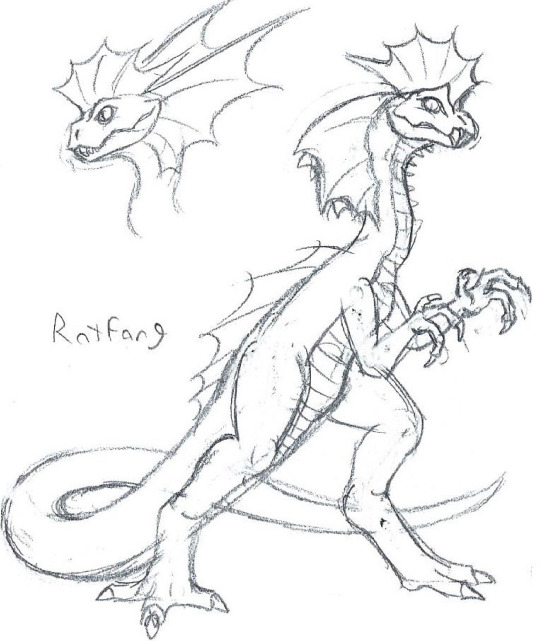
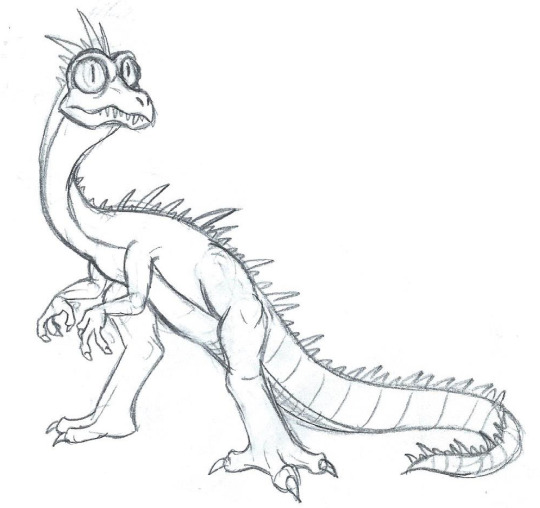
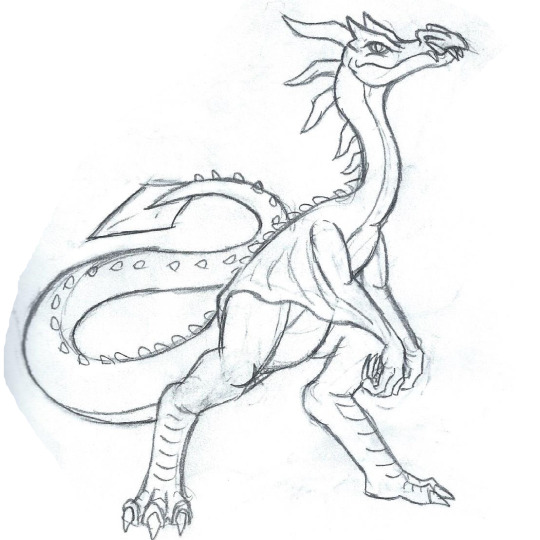
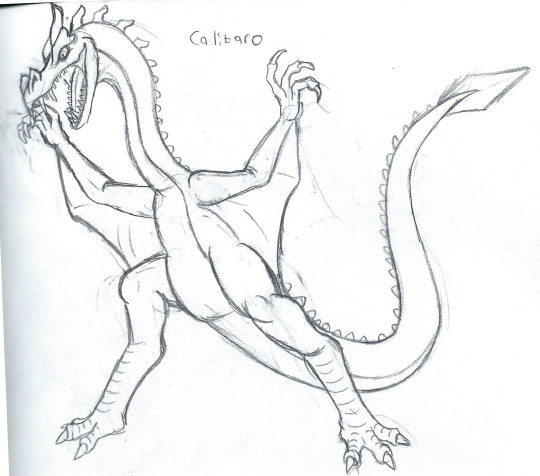
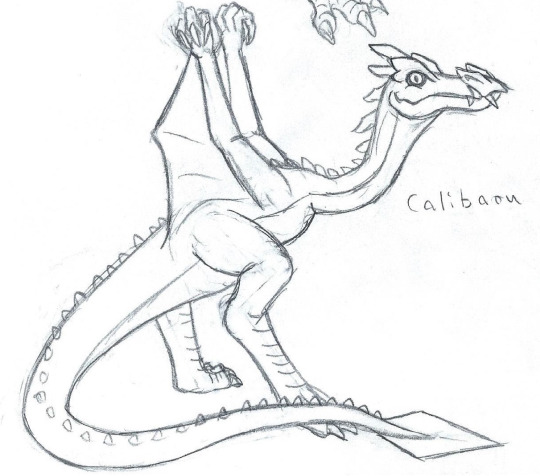
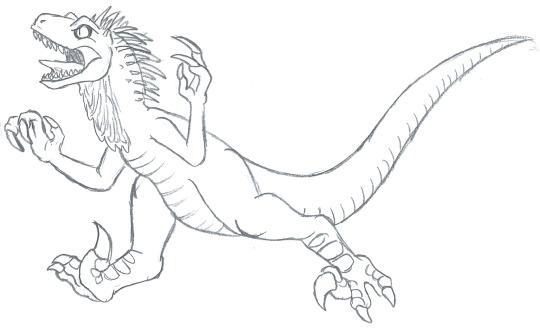
First, some from the tiny tyrant clade. We've got a Jurassic Park dilophosaur homage and one inspired by Saltopusuchus (my dad's favorite dinosaur from his childhood dinosaur book, purely because he pronounced its name "SaltopoSUCKus" - unfortunately for my dad, saltoposuchus is actually a crocodylomorph, though there is a dinosaur named Saltopus. Maybe his childhood book was confused?). There's a trio of ceolophysis-inspired ones who I envisioned as a sort of kaiju Team Rocket - they're got arm membranes to show that they're sort of a missing link between Tiny Tyrants and Flying Tyrants, and because it makes them look like they've got little dramatic villain capes. And a more 80's style dromaeosaur-inspired retrosaur than Colossaraptor, who obviously takes more from 90's retrosaur dromaeosaurs/JP raptors.
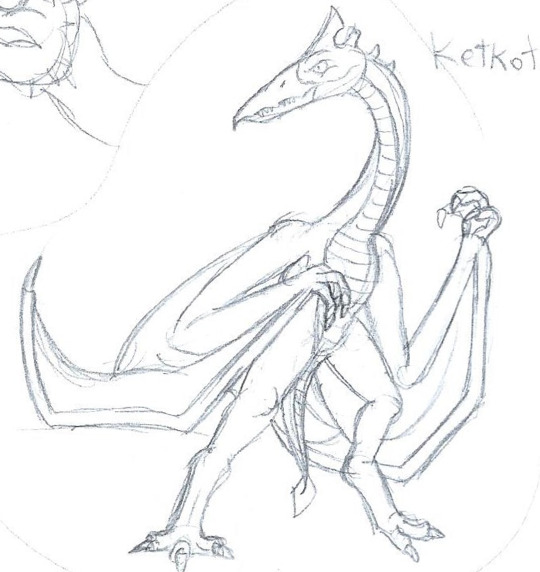
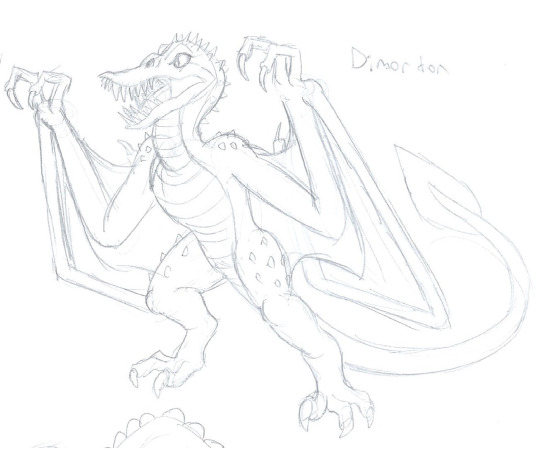
Next, a pair of Flying Tyrants. The first was a result of me looking at a Quetzalcoatlus skeleton and thinking just how fucking weird their proportions were, and the later is inspired by rhamphorhynchus, perhaps one of the most fucked up little guys in the fossil record.
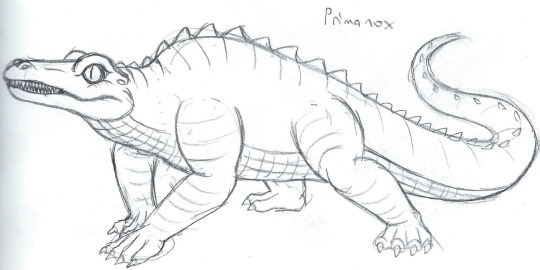
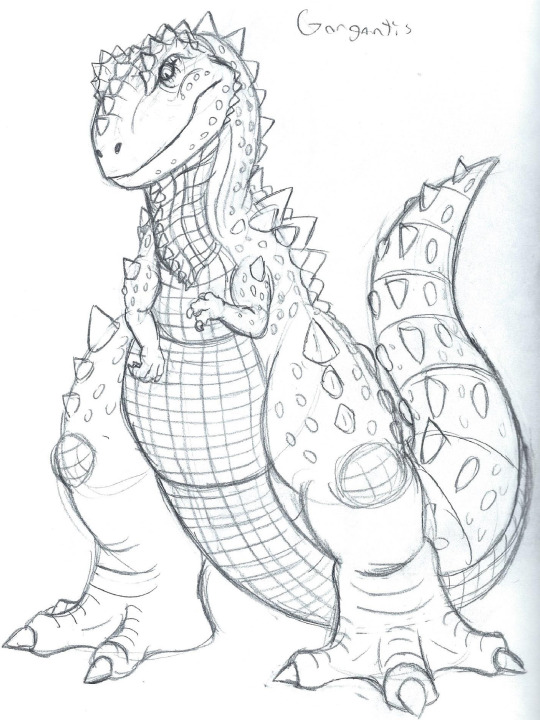
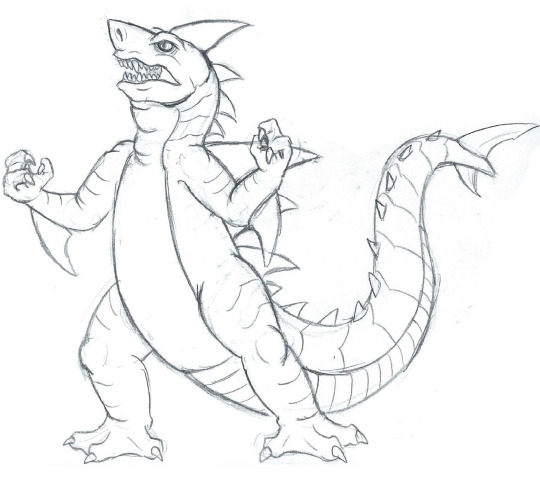
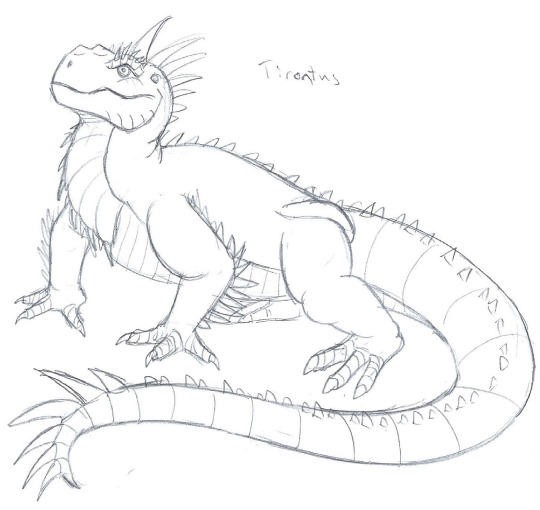
The final four of this section: a primitive carnivorous retrosaur inspired by the Crystal Palace Megalosaurus statue, a Bronton-sized True Tyrant inspired by the exaggerated depictions of Giganotosaurus in pop culture, a shark-like true tyrant inspired by Carcharadontosaurus, and finally... Tirontus. Tirontus is specifically inspired by the the 1960 film adaptation of The Lost World:
youtube
Which uses perhaps the most reprehensible of all atom age special effects, slurpasaurs. And I feel like even in its time no one bought this shit - any child would take the scene where Claude Rains says, "Look, a tyrannosaurus rex!" at what is clearly an iguana with rubber horns glued to its head and say, "That's not at all what a T.rex looks like. I've read books, dude." It's ridiculous.
And wouldn't it be funny if there was an ATOM story where some scientist finds a retrosaur kaiju that looks like, well, just a big lizard, and tries to pass it off as another Tyrantis? "No, no, this isn't just a big iguana, it's a tyrannosaurus rex!" So that's Tirontus, the false Tyrantis.
25 notes
·
View notes
Text
Holy shit, do people not know about how common a practice this was??? Like, it's so common there is a name for it (slurpasaurs) It's obviously not used today because... animal cruelty... if you want more information, here's a great video on the subject.
https://youtu.be/TlNRToxSwyU?si=X8goElwljb0zK-aG
TIL that there's an '80s movie where they portrayed Smilodon by sticking actual fake teeth onto actual live lions.
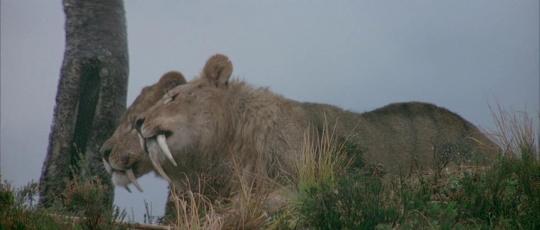
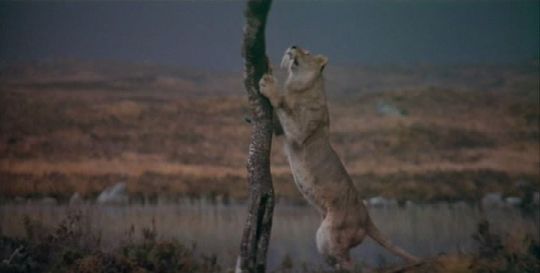
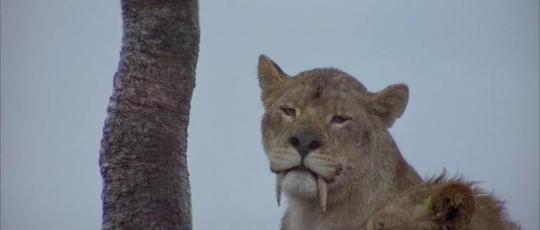
49K notes
·
View notes
Text
have yall seen retro paleoart?

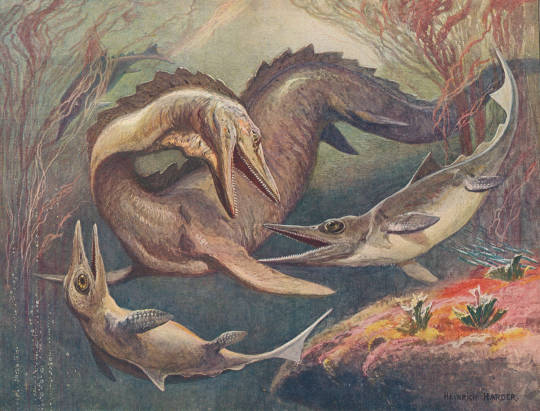
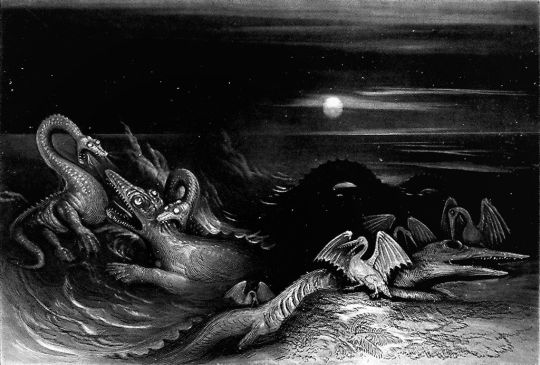
how shit thats cool
2K notes
·
View notes
Text
Slurpasaurs: A History
When it comes to classic dinosaur films, what is typically the first special effect that comes to mind which is used to bring the prehistoric beasts to life?
Stop motion with figurines like in The Lost World (1925)?
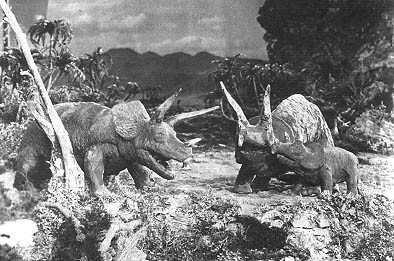
Suitmation made famous by Gojira (1954)?
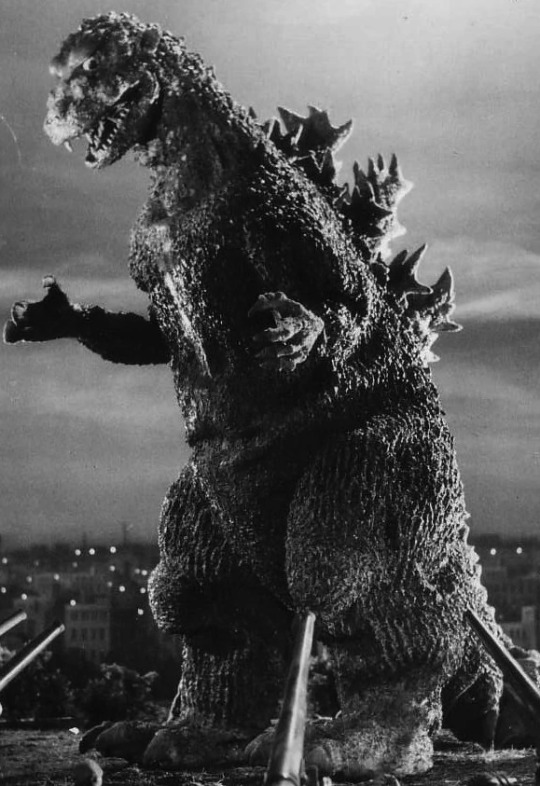
...put some crummy ass fins and horns on your pet iguana and call it a day?
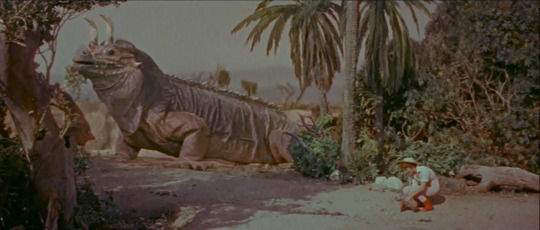
Yeah, we're gonna be talking about the last one for today's post.
The term "slurpasaur" is used to describe a peculiar method of bringing creatures to life that was used quite well up until the 60s. As I said, it refers to using a pet lizard or reptile and filming it in a way to appear more monstrous than they actually are (to...varying degrees of effectiveness). Usually this includes filming them close up and in slow-motion to give them more "weight" and make them appear larger. Horns, fins, and other adornments were often used to more vaguely resemble the dinosaurs they're supposed to portray.
Again, mileage varies on how this...uh..."creative" way of bringing dinosaurs to life works.
(Hint: it rarely did)
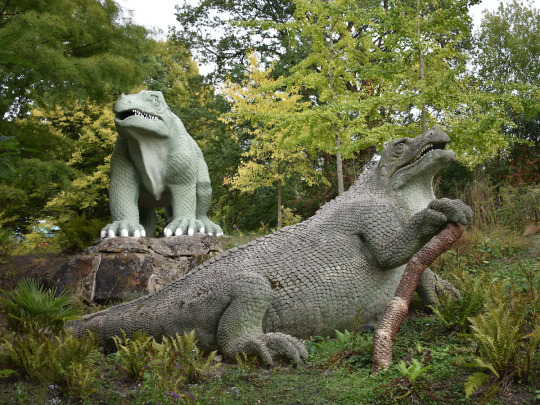

Dinosaurs and lizards actually do go quite back aways to their earliest depictions. When dinosaurs such as Iguanodon and Megalosaurus were first discovered, their remains were very fragmentary at best. And so early paleontologists had to do what they could to properly reconstruct these mysterious finds. Since the teeth and bones seemed to vaguely resemble reptiles, it was thought they were lizards. As seen in the two depictions above: the left being the famous Crystal Palace dinosaurs designed by Benjamin Waterhouse Hawkins, and the right being a painting of a Megalosaurus attacking an Iguanodon made by Édouard Riou.
Obviously future finds that showed dinosaurs weren't oversized lizards would render these depictions outdated, but the model would later find a surprising reemergence on the silver screen.
Since the use of stop motion was a slow, arduous, and expensive process while rubber suits had it's own set of problems (the suits being stiff and difficult to work in), the use of pet lizards provided a cheap and easy alternative. Not...necessarily the most effective special effects in the world, but movies are a business and sometimes in order to make some money back, you needed to cut some...
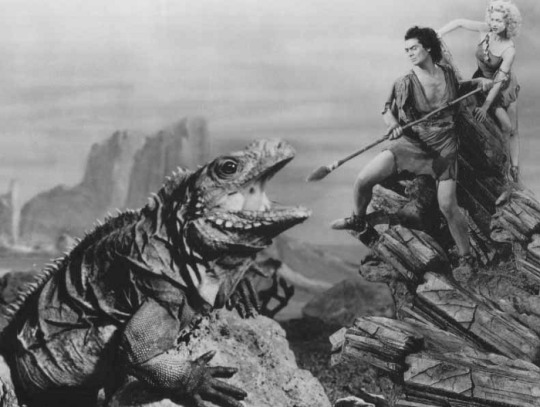
...corners.
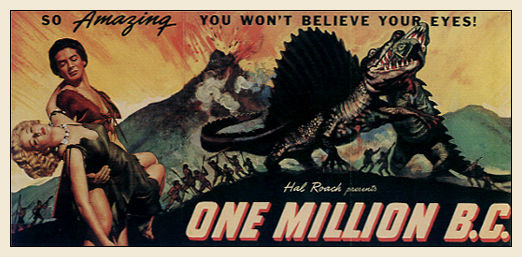
Among the first users of the slurpasaur technique is the 1940 "classic", One Million B.C. The plot involves a pair of cavemen tribes learning to live together in a prehistoric world filled with hungry predators and exploding volcanos. Interestingly enough, this film got nominated for an Academy Award for special effects.
Let's see what everyone was so excited about!
(Fair warning about the clip in question...animal rights weren't really a thing back then, so it involves an actual fight between a gator and a monitor lizard. Be advised)
One Million B.C. (1940) Gatorsaurus vs. Tegudon - YouTube
...huh. That's some...award winning effects right there.
One Million B.C is also one of the most well-known practitioners of the slurpasaur technique, and stock footage taken from this film is often used in many future films that depict dinosaurs that may also involve slurpasaurs. Including some of the films in this post. One of them is the 1961 Valley of the Dragons, which also inspired the name of this blog cause admittedly that is a cool name for a dinosaur film.
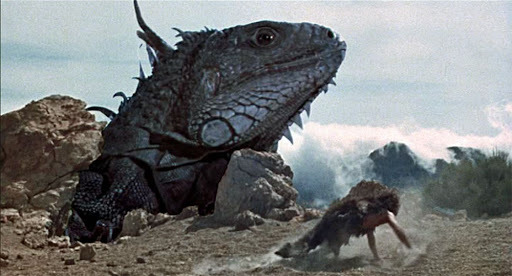
Interesting note before we move on: the One Million Years B.C remake (1966) also used an iguana in a rather late usage of slurpasaur. Partly to pay homage to the original film. And partly to show just how far special effects had come.
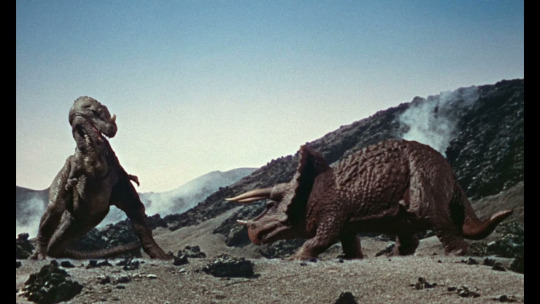
Considering that Ray Harryhausen was in charge of special effects...quite a lot.
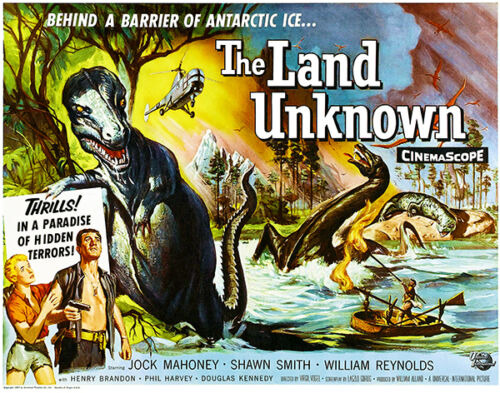
The next film on the list is The Land Unknown (1957) where a helicopter crashes in the South Pole and discovers a whole lost world of dinosaurs.
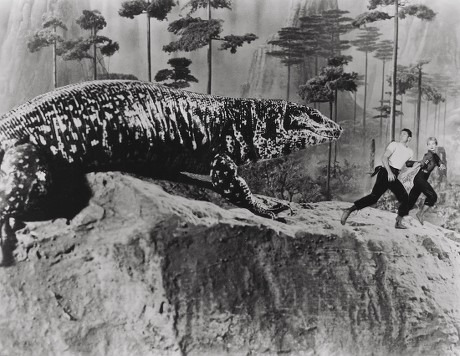
Who apparently evolved backwards to resemble monitor lizards.
Now to be fair, The Land Unknown didn't rely solely on slurpasaurs. Like One Million B.C it also used several other techniques to bring dinosaurs to life.
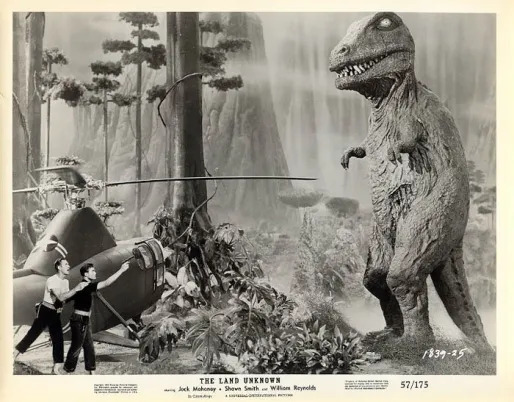
...which were just as effective.
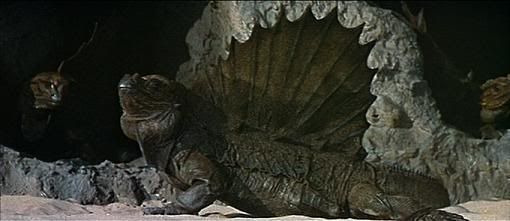
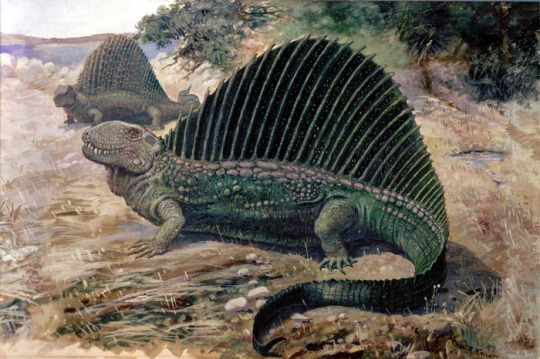
Now to actually be fair, there were a...very few amount of slurpasaur applications that aren't too bad. Take this depiction of Dimetrodon from Journey to the Center of the Earth (1959) which...wasn't too far off from older depictions of the species actually. I'll let this one slide.
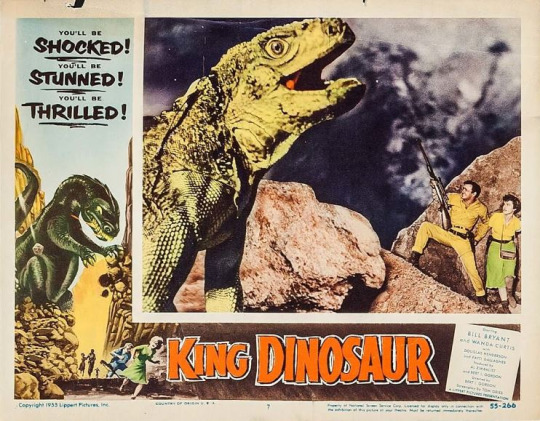
Not as forgivable is King Dinosaur (1955). Set on an alien planet that features similar animals to those on earth (allegedly), our "heroes" find themselves on an island populated by lizar-er, I mean "dinosaurs".
Again, to be fair, the slurpasaur idea could work if the animals in question were portrayed as generic prehistoric reptiles that weren't based on a specific species. Still looks silly, but at least there would be some reason for it.
Not with King Dinosaur. Here, two of our "heroes" are trapped in a cave by the eponymous King Dinosaur, where one of them, a noted biologist I might add, looks at what is clearly an iguana...and identifies it as a TYRANNOSAURUS REX.
To show I am not high and making this up, here is the clip in question with expected commentary from Joel and the bots.
MST3K: King Dinosaur (FULL MOVIE) - YouTube
Repeat, a skilled biologist looked at this guy:

And thought he was a T.rex, one of the most recognizable dinosaurs in all history.
You may take this moment to facepalm.
And it wasn't just King Dinosaur either. The 1960 remake of The Lost World had Professor Challenger identify a slurpasaur as a Brontosaurus. For a little clarity, here is what a Brontosaurus looked like back then and what Challenger saw.
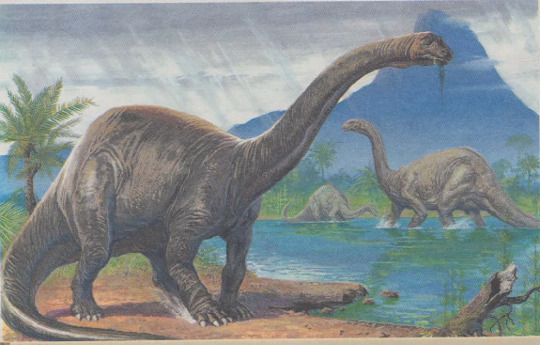

...can you see the family resemblance?
Which is part of the reason why the slurpasaur technique thankfully fell out of fashion since nobody can look at a lizard with fins and say that's a famous dinosaur. That and the gratuitous examples of animal violence. And that better effects were becoming cheaper and more accessible.
Nowadays the most you can expect from slurpasaurs is maybe a winking nod to their depiction. Like in this clip from South Park where the dinosaur is depicted by...a guinea pig.
guinea pig south park - YouTube
Only slightly harder to take seriously then an iguana trying to gum the viewer to death.
Which is the reason why slurpasaurs are fun to poke fun at. It's both absurd, silly, and kind of charming that early filmmakers tried to pass harmless lizards off as powerful and terrifying dinosaurs. These films do have that cheesy popcorn vibe that makes it fun to watch and bring up with friends.
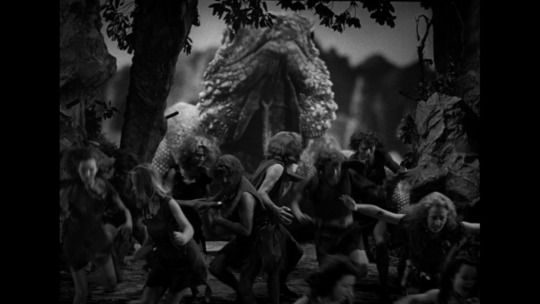
Cause nothing says so bad it's good when a bunch of cavemen try to fend off that iguana you saw at your local reptile convention.
#dinosaur#dinosaurs#paleomedia#paleoart?#b-movie#so bad it's good#slurpasaur#one million bc#king dinosaur#valley of the dragons#the lost world#journey to the center of the earth#long post
62 notes
·
View notes
Text



Slurptile (Poison)
Category: Fake Dino Pokémon
Abilities: Shed Skin/Simple
Hidden Ability: Unnerve
This was a Fakemon idea I’ve had stored in my mind for years and I am pretty glad to finally draw it.
Based off of Slurpasaurs, a type of miniature effect used in old prehistoric films where someone would take a lizard or crocodile, glue horns and spikes on it, then utilize a miniature effect on it to make it look gigantic, and call it a “dinosaur”.
Pictured are Normal, Shiny, and Ultra Shiny forms
2 notes
·
View notes
Text
Well, "realistic looking" in the sense of the 'color is inherently unrealistic' bullshit trend. But these lads… I like 'em! The bit about how they're used in movies also calls back to slurpasaur films - it's a nice touch.
Happy Dracones Monday! The Grey Wyvern
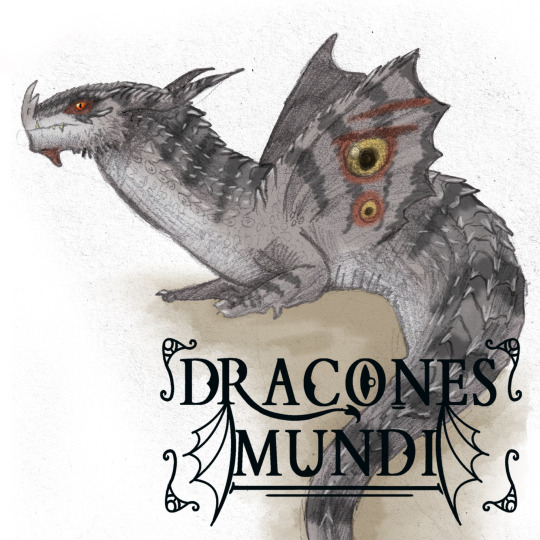
So, you go to the cinema to watch the latest block busting dragon movie, and the dragon is once again a grey spiky wyvern. Why is that? In the world of Dracones Mundi, the grey wyvern is a desert dwelling dragon native to North America. It hunts small mice and lizards around rocky crags, and, for some reason, are very easy to tame to perform tricks.
Back in the day the small wyverns were let loose on miniature sets, these days they perform swooping flights and spit venom 'fire' in front of a greenscreen. With some movie magic, they are scaled up and made to look gigantic and terrifying in films. Whatever your opinion on actor animals, these dragons are responsible for the public idea on what a dragon 'should' look like. Spiky, fierce, dark and bristling with spines.
For more dragons every monday, follow my project @draconesmundi
P.S I know irl the reason we get grey spiky wyverns in films is down to making realistic looking dragons, but I just aesthetically love them and despite all my dragons aiming for 'realism' I wanted to pay a tribute to this trope
139 notes
·
View notes
Photo
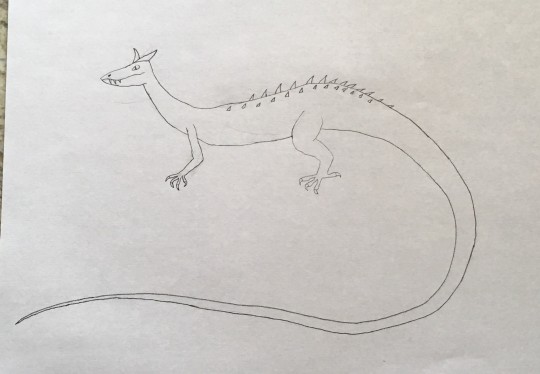
Tiratola, the Long-Tailed Terror!
Aliases: the Dragon of Etna, the Serpentine Savior, Our Lady of Flame
Date Discovered: May 20th, 1954
Place of Origin: Mt. Etna
Notable Stomping Grounds: Mt. Etna, Messina, Pisa, Stromboli Kaiju Reserve
Height: Generally holds head around 15 meters above the ground, but can rear up to tower at around 34 meters at her tallest.
Length: 115 meters
Biology:
A prehistoric varanid of enormous size from the same lineage that produced Kraydi, Tiratola brings to mind the dragons of yore, slinking and serpentine and adorned with a crown of fearsome crests and horns. Indeed, her Mediterranean location closely matches with depictions of dragons from the ancient Greeks and Romans, although her demeanor is hardly that of a rapacious devourer of maidens and hoarder of gold.
Rather than her jaws, Tiratola’s primary weapon of choice is her tail - even for a reptile, hers is incredibly long and dexterous, making up more than half of her total body length and as flexible and powerful as the body of any snake. With it, she can lash at targets several hundred feet away, coil and constrict her opponents, and even pick up and hurl objects as big as buildings or handle very small objects with the very tip of the tail like an elephant’s trunk. Indeed, her style of combat is very similar to that of the American kaiju Gorgolisk, preferring to coil and constrict her opponents with her powerful body.
As a kaiju, Tiratola also sports a fairly standard powerset:
Super strength
An enhanced healing factor
Immunity to radiation
She also has one more trick up her sleeve - like many other prehistoric varanids as well as Tyrantis himself, the Terror of Italia sports venom glands within her jaws that she can either ‘chew’ into her opponents or spray like a spitting cobra, and like Tyrantis, this venom has further honed into a flammable compound like something out of the pages of myth and legend.
Of course, comparing Tiratola’s fire spitting with Tyrantis’ flaming breath would be akin to comparing a firecracker with a flamethrower - rather than napalm-like torrents of ignited venom, the enormous reptile’s sprayed venom ignites into a cloud of scalding sparks and embers that explodes outwards in a shotgun-like blast with a loud crack and a blinding flash. While it’s not the best at actually damaging opponents, it still stings and burns quite painfully for targets, especially if hit in the eyes and other sensitive areas, and the sharp rapport of the venom combusting can cause a few seconds of disorientation. Injecting the stuff into the bodies of opponents, however, produces rather more grisly results as it reacts with oxygen in the bloodstream, causing the wounds inflicted by her teeth to burst open a few seconds after she lets go. To a kaiju’s durability and regeneration, it’s not nearly as harmful as it looks unless Tiratola injects a truly immense amount of venom or her opponent is considerably smaller than herself, but it’s still quite painful to experience.
History & Personality:
When the Superquake of ‘54 rocked the world, the actual tremors weren’t the only force behind the resulting destruction - tidal waves lashed the coasts, avalanches and rockslides buried towns, and a number of already-rumbling volcanoes were roused to erupt once more, pushing up not only molten material but all manner of strange new landforms forged from the Yamaneon tunnels beneath the earth. Home to several volcanoes as they are, Greece and Italy were particularly subject to this, disgorging an assortment of subterranean environments alongside quite a number of kaiju. Among them was the great reptile Tiratola - emerging from the volcanic aftermath of Mt. Etna, the serpentine saurian made herself known to the public at large when she swept through the outskirts of Messina and smothered a major fire when she settled herself on top of it for warmth, inadvertently saving much of the city from burning to the ground. In the aftermath of the fire, she would go on to save even more lives as she nosed around the rubble, unearthing nearly two dozen people that had been trapped beneath fallen debris.
Since her awakening, Tiratola has come to roam across Italy and Greece, frequently digging people out of rubble wherever she went and frequently engaging smaller mutants emerging from local Yamaneon tunnels as well as the occasional full-on kaiju - her most famous scuffles include preying upon a hoard of Paleozoic invertebrates that emerged from a Carboniferous swamp in the Greek Kassandra Peninsula and engaging a hulking one-eyed hominid kaiju that had been menacing the city of Taranto, dragging it down to its doom beneath the waves before it could do anything worse than superficial damage to buildings. Aside from an incident involving the Leaning Tower of Pisa, she’s been responsible for relatively little destruction, and has become somewhat of a local hero to the populace of the regions, something that Tiratola has come to notice.
Low to the ground as she is, the Whip-Tailed Terror is by her nature literally closer to human beings than many other kaiju, and is more aware of their activities as a result. She’s come to recognize how people react to her presence and realizes how easily she can reshape the tiny world that she now finds herself in. Were she a more malevolent sort, this awareness and her ability to easily wind through city streets could potentially make her an incredibly dangerous thrat to human beings, but the ultimate result of this is that Tiratola has come to realize that she quite enjoys the attention and praise she gets from acts of heroism. Being a reptile, she is by nature a very energy-efficient creature, conserving her strength when she does need to exert herself… but being a kaiju, acts of aid towards humans are trivially easy for her. A couple sweeps of her tail can smother a major fire beneath dirt and water and pulling people from danger can be easily accomplished by simply pushing her head into, say, a burning building and using her keen senses to locate survivors in the same way that modern varanids break into termite mounds and locate warm chambers to lay their eggs in or mother crocodiles dig out their young from nests. It costs little to the great reptile to lend her aid to others, and the reward for doing so is more than worth it - adoration and cheers whenever she enters a populated area, occasional offerings of fish and other treats, even occasional cleanings by teams of volunteers that scrub her down and aid in peeling off any lingering bits of unshed skin. The latter task has also provided another boon to the people of Greece and Italy - analysis of Tiratola’s shed skin has shed a lot of light on kaiju cellular biology, and the scales themselves are durable enough to be shaped and worked like metal or glass, fostering a small but lucrative industry of decorative items made from the kaiju’s scales.
However, there may also be another reason for her gentleness towards humans - while unearthing survivors from rubble, Tiratola frequently makes vocalizations not unlike those of crocodilian and alligator parents when unearthing their buried young, even scooping them up in her jaws in a similar fashion to carry them to safety. It may be that trapped survivors reminds the the whip-tailed dragon of her own offspring, buried in sand and soil - joint Reptodite-human expeditions into the collapsed tunnels where the kaiju emerged have even found the crystallized remains of ruined nests and cracked eggs, suggesting that she may have produced several clutches of offspring before via parthenogenesis in the same manner as some species of monitor lizard, although none seem to have survived.
Behind the Scenes:
Behold, my entry to @tyrantisterror ’s ATOM Create a Kaiju Contest 3D, Tiratola! I’ve entered both of his previous contests, and I didn’t want to miss out here, although this is admittedly my first time posting one here to Tumblr; there’s a bunch of really creative kaiju already entered into the competition, and I highly recommend checking them out. My entry really isn’t the best by far (I wanted to make Tiratola a lot lengthier and more serpentine, but I didn’t have the space to do it, and I can’t really do detail work for shit), but I’m still reasonably happy with how my girl Tiratola came out!
Tiratola is meant to be an homage to that tried-and-true staple of the monster movie genre - movie companies from other countries trying to cash in on a trend! It’s how the world got creatures like Gorgo, Paleosaurus, and Reptilicus - creatures whose movies were far from the source material, but were packaged as being the same thing in their posters and translated titles overseas, leading to weirdness like Godzilla vs Mothra becoming ‘Watang and the Fabulous Kingdom of Monsters’ in its Italian release, the infamous cut of ‘The Volcano Monsters,’ and so on. As such, she takes the basic concept of Tyrantis - ‘giant green prehistoric reptilian monster with a long tail and horns that breathes fire’, and reconstructs it through that lens. To that end, she’s also somewhat based on slurpasaurs and on cheap rubber props, staples of Italian monster cinema.
Designwise, I based her quite heavily on, well, monitor lizards as well as the classic LEGO dragon model plus the movie poster design for Reptilicus - both are a nice combination of reptilian features that doesn’t really lend itself to any particular order, with Kraydi factoring in as another reference. Indeed, Tiratola’s meant to be a cousin to that kaiju, another of the varanid lizard lineage that would have lead to dragons and their kin in the Lost Epoch - she’s meant to be a bit farther down that evolutionary line than Kraydi is, but still not exactly a direct ancestor.
I was struggling to get a feel for Tiratola’s personality at first, but I managed to get something when I reread ATOM and the way that its reptilian stars think, plus some takes on protective dragons and why they defend humans so much smaller and weaker than they. A big part of this series is about how the kaiju are far more intelligent and empathetic than they let on - I thought it’d be neat to play off of that. While her motivations come from a very different place than they would in a human being or a similar creature, the end result is still the same: if it feels good to help others, and doing so is relatively easy, why not do so? I also added a good deal of Ogra and Reptisaurus as well - I figured it would be only fitting.
The thing about her visiting Pisa is a nod to Dinosaurs Attack, the card where the Rhedosaurus and Giant Behemoth teamed up to destroy the Leaning Tower, while her battle with the giant is taken from the battle between the dragon Taro and the Cyclops in The Seventh Voyage of Sinbad. The date of her discovery is also the date that Reptilicus was released in theaters, albeit moved back a few years.
#tyrantisterror#kaiju#atomic time of monsters#Reptilicus#gorgo#dragons#my crappy art#The ATOM Create a Kaiju Contest 3D#slurpasaur#tiratola#italy#dinosaurs attack#tyrantis
14 notes
·
View notes
Note
Even better idea: the "Kaiju" is very obviously a cat walking around a model city, with all humans being (badly) greenscreened in.
A slurpasaur cat kaiju! That would be fun!
And the humans are badly blue screened in in the way people would be in the old Godzilla movies, with an obvious blue hue around them all as they run for their lives!
Whenever the cat kaiju sneezes it sneezes obviously 2d animated fire that explodes, and any people in the houses are obvious still dummies!
And whenever the models crumble they do it in a very unconvincing way!
#kaiju#slurpasaur#stylistic suck#these effects would be so bad eiji tsubaraya would crawl out of his grave just to strangle the person responsible for it!
7 notes
·
View notes
Text
Indeed! Except for the guys who used Slurpasaurs. I swear, One Million BC Footage has as much use as The Lost World (1925) does and it's painful every time!
What's most amazing about people who hate that birds are dinosaurs is that, without the discovery of birds being dinosaurs in the 1960s, none of y'all would have ever actually cared about dinosaurs
the history:
dino craze in 1800s. people thought, birds are very similar to these guys. Dollo fucked it up, made a bad theory, and people stopped thinking that
Early 1900s, dinosaurs deemed sluggish, stupid, pointless evolutionary failures. most people not really into dinosaurs anymore. this continues until
1960s: Deinonychus discovered. suddenly, dinosaurs interesting again: vibrant, lively, warm blooded animals. Also... birds might be dinosaurs?
from the 60s through the 70s, a slow buildup of dinosaur culture - both in crappy stop motion movies, but also in children's books and other media
80s cladistics revolution shows birds are living dinosaurs, though not without flaws. documentary after documentary is made, causing the major dinosaur boom of the late 80s and early 90s
the peak of this boom are the A&E and PBS documentaries, which both outright state birds are dinosaurs
cartoons like land before time and other dinosaur content keep coming out too, especially at the end of the 80s and the earliest 90s
the book jurassic park, referencing the birds are dinosaurs thing, is written in the late 80s. in the early 90s, is adapted into one of the greatest blockbusters of all time. now dinosaur interest is MAINSTREAM.
jurassic park isn't the start of the dinosaur boom, it is the apex
90s becomes the decade of dinosaurs, with tons of new discoveries, television shows, documentaries, and other programming
1996 first feathered "nonavian" dinosaur discovered. birds are dinosaurs is the closest thing we have to proven phylogenetic fact
1999 walking with dinosaurs premieres, revolutionizing the dinosaur-documentary genre.
early 2000s becomes the age of Period-Type Dino-Docu-Dramas
velociraptor is determined to have feathers
suddenly, dinosaur mania starts to die in the later 2000s
even though discoveries keep happening and we learn so much in the 2010s, the 2010s becomes a very regressive time - a sort of reactionary response to the birdification of dinosaurs and the dinosaurification of birds. the height of this is jurassic world
we may be in the middle of a dino-docu-drama revitilization thanks to prehistoric planet. stay tuned on that one
like, everyone was fine with the birdification of dinosaurs up and until they looked "feminine" on the outside, because of feathers.
It's just all such transparent misogyny and homophobia and people who react against feathered dinosaurs or birds being dinosaurs are just... so transparently parroting conservative talking points
Anyways, yeah. without birds are dinosaurs, you wouldn't have jurassic park. Sooooo
2K notes
·
View notes
Photo

Oh come on, that monitor’s breath isn’t that bad. (The Lost World, 1960)
55 notes
·
View notes
Text
Crappy Dinosaur Movies!
I've seen a lot of crap dinosaur movies -- and I'm always up for more, but this is a bridge too far! After video babysitters of the 20th and 21st centuries, after slurpasaurs, after Jurassic Knockoffs and Asylum. This is what got me to take a break on it.

Take a look at this animal. Generic T. Rex head, prominent brow horn, uniform teeth. Usually, when you see a horn like that, it's easy to call it out as Ceratosaurus.
Not here! In the Trailer for the 2022 film Timescape, this pixilated piece of putrefaction is instead dubbed a T. Rex. I haven't seen a T. rex with a horn on its nose that big since King Dinosaur -- and that was actually an Iguana!
And I just finished watching a film, Hatched (2021) which was actually rather decent. Definitely a B-Movie, but there was definitely effort put into it. The rendering and integration of the dinosaurs there could have been better, but they looked like what they were portraying (the "Raptors" we Deinonychus, with the proper head shape and sizes! Their hands were pronated! No feathers, though, but I'll take what I can get on a low budget!). To follow it up by seeing this trailer? Man, it was a hard hit! Though to be fair, Hatched cleansed my pallet after finding out someone's trying to make a sequel to Area 407, and seeing Wolf Tracer's Dinosaur Island and the worst video babysitter I've yet seen: Dino Brained. Seeing that name applied to a horned therapod like that brought me right back to Dino Brained and them passing off Albertosaurus as Abelisaurus.
On the plus side, I can now say: "If I had a nickel for every Dinosaur movie with Zombies, I'd have 3 nickels. Which isn't a lot, but it's weird that it's happened 3 times."
#Timescape#Movie#Dinosaur#Dinosaurs#Paleomedia#Paleoart#Hatched 2021#Hatched#Tyrannosaurus#Ceratosaurus#Deinonychus#Velociraptor#Area 407#Dino Brained#Wolf Tracer#Dinosaur Island#Wolf Tracer's Dinosaur Island
36 notes
·
View notes
Text
Shringasaurus indicus
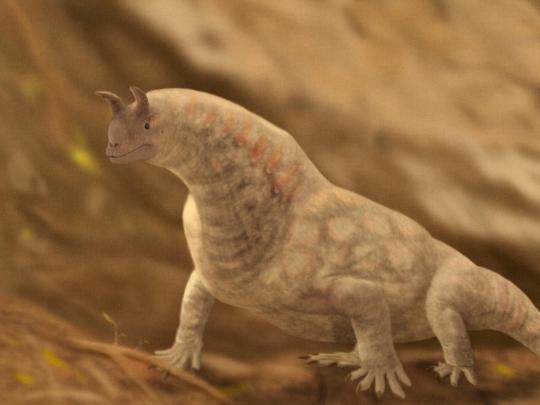
By Stolp
Etymology: Horned Reptile
First Described By: Sengupta, Ezcurra & Bandyopadhyay, 2017
Classification: Biota, Archaea, Proteoarchaeota, Asgardarchaeota, Eukaryota, Neokaryota, Scotokaryota Opimoda, Podiata, Amorphea, Obazoa, Opisthokonta, Holozoa, Filozoa, Choanozoa, Animalia, Eumetazoa, Parahoxozoa, Bilateria, Nephrozoa, Deuterostomia, Chordata, Olfactores, Vertebrata, Craniata, Gnathostomata, Eugnathostomata, Osteichthyes, Sarcopterygii, Rhipidistia, Tetrapodomorpha, Eotetrapodiformes, Elpistostegalia, Stegocephalia, Tetrapoda, Reptiliomorpha, Amniota, Sauropsida, Eureptilia, Romeriida, Diapsida, Neodiapsida, Sauria, Archosauromorpha, Crocopoda, Allokotosauria, Azendohsauridae
Status: Extinct
Time and Place: Between 247.2 to 242 million years ago, in the Anisian of the Middle Triassic
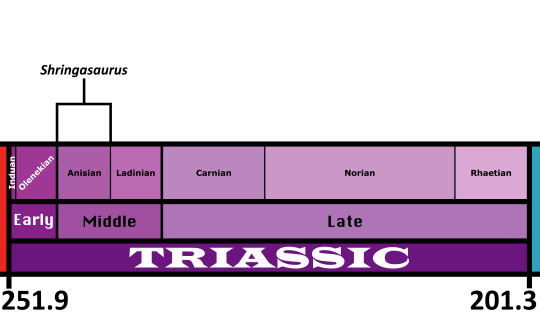
Shringasaurus is known from the Denwa Formation in Madhya Pradesh, India

Physical Description: Shringasaurus is a very strange looking reptile (befitting of the allokotosaur title), and basically looks like one of those retro ‘slurpasaurs’ from those old dinosaur movies where they just glued horns onto an iguana. At around 3–4 metres long, Shringasaurus was pretty large for a Middle Triassic archosauromorph, and could have potentially stood tall enough to look you in the eye. Shringasaurus had some very unusual proportions, with a small blunt-snouted head on a long, very thick neck attached to some very deep shoulders with tall withers over them. These chunky forequarters contrast with its rear end, with proportionately small hips and a tail that is relatively short compared to other stem-archosaurs. Of course, its most famous features are its bizarre horns over its eyes. These are remarkably similar to the horns of ceratopsid dinosaurs like Triceratops, and are yet another fabulous example of the Triassic doing everything dinosaurs did first. These horns can be as tall as the skull again in large individuals, and curve to face up and forwards. These horns were proportionately smaller in younger animals, and so likely grew in as they matured. Interestingly, one juvenile specimen lacks horns at all, even though a similar sized specimen has them, suggesting that some Shringasaurus, possibly females, didn’t have them. Even on closer inspection Shringasaurus is weird. For instance, it has palatal teeth like some other reptiles, but lots of them, and they’re all shaped exactly like the teeth on the edges of its jaws. No other reptile besides it and its close relative Azendohsaurus have teeth like that. Just imagine how that would look when it opened its mouth.
Shringasaurus embodies the typical azendohsaurid body plan of combining bizarrely ‘advanced’ sauropod-like traits with those of more ‘primitive’ archosauromorphs. Its long neck and small head has obvious superficial similarities, but features of its jaws and teeth are so sauropod-like that they’re only seen in sauropods themselves and azendohsaurids like Shringasaurus—yet another remarkable example of convergent evolution in these animals. Features of its arms are similar to sauropodomorphs too, but its posture was decidedly more ‘primitive’ than them. Its back legs sprawled completely, like those of a lizard, and while the front legs weren’t anything as upright as sauropods, they may still have been held more off the ground in a sort of semi-sprawl than the back ones. This would have given Shringasaurus a sloped back and raised the head and neck higher above its shoulders, so in a way it was still superficially sauropod-like. With horns.
Diet: Shringasaurus was clearly a herbivore from the shape of its teeth, which are leaf-shaped and serrated (indistinguishable from herbivorous dinosaur teeth, infact). The teeth and jaws of its close relative of Azendohsaurus have been studied in detail, and suggest it preferred feeding on the softer parts of plants like leaves rather than tough stems and branches. Shringasaurus had similar teeth, so it likely fed on soft vegetation also. Quite how it used its freaky palatal teeth is anyone’s guess.
Behavior: Not much can be said for sure about its behaviour, but since so many Shringasaurus individuals were found together of different ages, it’s possible that they lived in mixed-aged herds. Sexual dimorphism, if really present, would be a good indicator that the horns were used at least for display, but like the horns of ceratopsids and living bovids it’s also possible they were used in combat, locking their horns in jousts to settle disputes over food, mates, territory, or anything else they might have been grumpy over. The shape of the horns in particular implies they were mostly likely used for this kind of wrestling.
Ecosystem: Shringasaurus co-existed with a decent variety of other typical mid-Triassic animals in the Denwa Formation. Other large herbivores included two dicynodonts, one a stahleckeriine and the other more like the older Kannemeyeria, as well as an early rhynchosaurid. No less than four temnospondyl amphibians are known from there, including the predatory Cherninia and Paracyclotosaurus crookshanki, a brachyopoid (think Koolasuchus), and a long-snouted gharial-like trematosaurid. The extinct lungfish Ceratodus was also swimming around here too. Shringasaurus was one of the largest animals known in this ecosystem, and probably would have only rubbed shoulders with the large stahleckeriine dicynodont for food sources, browsing on tall, lush plants out of reach of the other herbivores. The environment was a broad, semi-arid floodplain with slow meandering rivers, subject to seasonal rainfall and droughts that may have periodically dried up rivers and ponds.
Other: Shringasaurus belongs to a recently recognised group of archosauromorphs called Allokotosauria, the “strange reptiles”, which includes other peculiar stem-archosaurs like Trilophosaurus and bizarre Teraterpeton. Allokotosaurs all appear to be herbivores, and can be characterised by their strange teeth, but they’ve all got different types of them! Shringasaurus and other azendohsaurids all have jaws full of teeth (including the roof of the mouth) that look just like herbivorous dinosaur teeth. The resemblance is so uncanny that Azendohsaurus was considered to be a dinosaur for decades before the rest of its body was discovered. Trilophosaurids meanwhile have a characteristic beak, which in the unique case of Teraterpeton is so long and pointed that it vaguely resembles an anteater, and their teeth are cusped and interlocking for shearing leaves.
Early archosauromorphs used to be thought of as mostly carnivores and insectivores, while the role of large herbivores was dominated by the synapsid dicynodonts in the Early and Middle Triassic, with archosaurs like dinosaurs and aetosaurs, as well as the rhynchosaurs, only taking over in the Late Triassic. Allokotosaurs like Shringasaurus demonstrate that this was wrong, and that stem-archosaurs were just as capable of being derived herbivores capable of competing with synapsids in the Middle Triassic just as well as the later derived rhynchosaurs and archosaurs, including at large sizes as big as Shringasaurus. Intriguingly, there’s evidence to suggest that Azendohsaurus was endothermic to some degree, i.e. warm-blooded, and given their close relationship it’s probable that Shringasaurus was too. This would make azendohsaurids like Shringasaurus some of the earliest stem-archosaurs to have been warm-blooded!
~ By Scott Reid
Sources under the Cut
Bandyopadhyay, S. and Sengupta, D.P., 1999. Middle triassic vertebrates of India. Journal of African Earth Sciences, 29(1), pp.233-241
Cubo, J.; Jalil, N.-E. (2019). "Bone histology of Azendohsaurus laaroussii: Implications for the evolution of thermometabolism in Archosauromorpha". Paleobiology. 45 (2): 317–330
Ghosh, P., Sarkar, S. & Maulik, P. Sedimentology of a muddy alluvial deposit: Triassic Denwa Formation, India. Sedimentary Geology 191, 3–36 (2006)
Goswami, A.; Flynn, J.J.; Ranivoharimanana, L.; Wyss, A.R. (2005). "Dental microwear in Triassic amniotes: implications for paleoecology and masticatory mechanics". Journal of Vertebrate Paleontology. 25 (2): 320–329
Maulik, P. K., Chakraborty, C., Ghosh, P. & Rudra, D. Meso- and Macro-Scale architecture of a Triassic Fluvial Succession: Denwa Formation, Satpura Gondwana Basin, Madhya Pradesh. Journal Geological Society of India 56, 489–504 (2000)
Mukherjee, R.N. and Sengupta, D.P., 1998. New capitosaurid amphibians from the Triassic Denwa Formation of the Satpura Gondwana basin, central India. Alcheringa, 22(4), pp.317-327
Mukherjee, D., Sengupta, D.P. and Rakshit, N., 2019. New biological insights into the Middle Triassic capitosaurs from India as deduced from limb bone anatomy and histology. Papers in Palaeontology
Nesbitt, S.J;, Flynn, J.J.; Pritchard, A.C.; Parrish, M.J.; Ranivoharimanana, L.; Wyss, A.R. (2015). "Postcranial osteology of Azendohsaurus madagaskarensis (?Middle to Upper Triassic, Isalo Group, Madagascar) and its systematic position among stem archosaur reptiles". Bulletin of the American Museum of Natural History (398): 1–126
Robinson, P. L. 1970. The Indian Gondwana formations–a review. In First IUGS International Symposium on Gondwana Stratigraphy and Paleontology, 201–268
Sengupta, S.; Ezcurra, M.D.; Bandyopadhyay, S. (2017). "A new horned and long-necked herbivorous stem-archosaur from the Middle Triassic of India". Scientific Reports. 7: 8366
#Shringasaurus#Shringasaurus indicus#Reptile#Archosauromorph#Triassic#Triassic Madness#Triassic March Madness#Palaeoblr#Allokotosaur#Prehistoric Life#Paleontology#Prehistory
364 notes
·
View notes